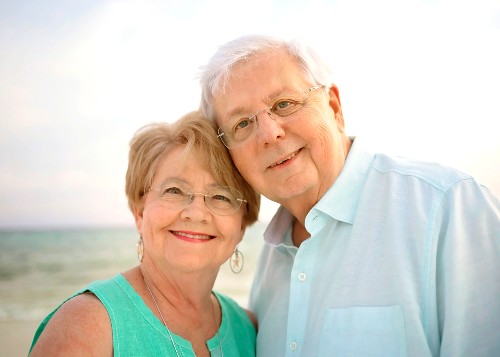 The entire time her husband was hospitalized, Carol Thompson kept a Hawaiian shirt hanging in his hospital room, within his eyesight to serve as a reminder of his goal – to recover from his strokes, so they could go on a Hawaiian vacation with their entire family.
The entire time her husband was hospitalized, Carol Thompson kept a Hawaiian shirt hanging in his hospital room, within his eyesight to serve as a reminder of his goal – to recover from his strokes, so they could go on a Hawaiian vacation with their entire family.
In February 2008, Gary Thompson had a health crisis while at work in Midland, Texas. His coworkers got him to the hospital where he was diagnosed with an ascending thoracic aortic dissection, a life-threatening condition that happens when two of three layers of the aorta (the major artery from the heart to the body) split apart. Gary was transported to a Houston-area hospital for surgery. At the Houston-area hospital, Carol was warned that Gary could have a stroke as the result of his condition and subsequent surgery.
“He actually had multiple strokes,” said Carol. “He was in the ICU for a month, in a coma and on a ventilator. He was unresponsive. That’s when I first hung up the Hawaiian shirt in his room.”
Gary was not given much chance of recovery.
“I was encouraged to take him to a nursing home,” said Carol. “But one of our son’s friends told us about  TIRR Memorial Hermann. Since I was already in Houston, I made an appointment to tour the facility and see it first-hand. For the first time in a long time, I felt hope when I walked into TIRR Memorial Hermann.”
TIRR Memorial Hermann. Since I was already in Houston, I made an appointment to tour the facility and see it first-hand. For the first time in a long time, I felt hope when I walked into TIRR Memorial Hermann.”
In April 2008, Gary was admitted to TIRR Memorial Hermann. He entered the hospital on a stretcher, but Carol’s goal was for him to walk out on his own when he was discharged. Once he was settled into his room, she hung up the Hawaiian shirt.
“We initially began working with Gary on being able to just sit up on the edge of the bed or being able to transfer from the bed to the wheelchair,” said his physical therapist Cori Pace, PT, MPT. “We then progressed to standing and shifting his weight onto his affected side, and then eventually he was able to take a few steps. Throughout his therapy, we incorporated his wife, Carol, into much of his treatment so that she could start learning how to help him and be prepared for taking Gary home. She was with him the entire time and together they focused on his goals, including travel. His motivation to participate, along with her support and presence, were key to his recovery.”
As part of his physical therapy, his team even had him practice walking on sand to prepare Gary for the Hawaiian vacation he was working towards. His physical therapists also co-treated with music therapy in collaborative care that was designed to facilitate functional movements. According to Carol, the first thing Gary said following his strokes was the “Happy Birthday” song during music therapy.
“Gary participated in several music therapy groups -- he worked incredibly hard and was a delight to work with,” said his music therapist Amy Marroquin, MT-BC.
His occupational therapy clinician, Dawn Philips, COTA, recalls how committed Gary was to reaching his goals. She said, “No matter the task introduced during his therapy sessions, Gary gave it his all, he understood that he was the one who ultimately had to put in the hard work. Seeing Gary's determination, pushed me as a clinician to engage him in highly complex activities. This meant having do things such as stepping up on a six-foot-tall ladder in a manner that forced more of his weight into his affected leg, while also stabilizing his affected hand on a ladder rung and being given verbal instructions to use his other hand to place objects on top of the ladder. The task forced him to work on the strength and endurance in his affected limbs, his trunk control and the ability to shift his weight, improve his visual scanning of the environment and process verbal instructions being given followed by decision making. His engagement in complex, novel and challenging tasks aided in the promotion of neuroplastic changes in his brain to give him an advantage in being able to resume his life roles and goals.”
Following his initial inpatient stay at TIRR Memorial Hermann, Gary was discharged to return home. At that point he could take a few steps, could say a few words and take care of some personal care such as shaving on his own. He returned to TIRR Memorial Hermann to continue two more phases of his rehabilitation.
In March 2009, Gary discharged from TIRR Memorial Hermann inpatient care for the final time. He returned home to Midland where he had outpatient therapy.
“Gary walked out of TIRR Memorial Hermann!” said Carol. “That same year we took our trip to Hawaii along with our entire family! Gary walked around the airports without a wheelchair. He walked on the sand just like he practiced at TIRR Memorial Hermann. Since then, we have been on so many vacations – including to Niagara Falls, Alaska, New York, California, British Columbia and Puerto Rico. We could not have done this without TIRR Memorial Hermann!”

Nationally Ranked Rehabilitation
For the 36th consecutive year, TIRR Memorial Hermann is recognized as the best rehabilitation hospital in Texas and No. 2 in the nation according to U.S. News and World Report's "Best Rehabilitation Hospitals" in America.
Learn more about TIRR Memorial Hermann rankingsContact Us
If you have questions or are looking for more information, please complete the form below and we will contact you.